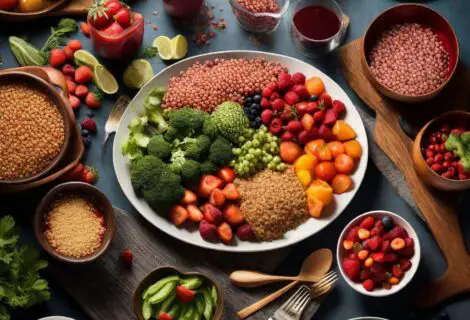Top 10 Tips for Creating a Balanced Meal Plan
Introduction
Creating a meal plan can be overwhelming, especially when you’re trying to make sure that your meals are both healthy and delicious. However, with the right knowledge and tools, creating a balanced meal plan can be a breeze. In this post, I’ll share the top 10 tips for creating a balanced meal plan that will help you achieve your health goals.
Top 10 Tips for Creating a Balanced Meal Plan
1. Start with a balanced plate
The first step in creating a balanced meal plan is to start with a balanced plate. This means making sure that each meal includes a variety of food groups, such as fruits, vegetables, whole grains, lean proteins, and healthy fats. Aim for a plate that is half-filled with fruits and vegetables, a quarter with whole grains, and a quarter with lean proteins.
2. Choose nutrient-dense foods
When planning your meals, focus on choosing foods that are nutrient-dense, meaning they provide a lot of nutrients for their calorie content. Nutrient-dense foods include fruits, vegetables, whole grains, lean proteins, and healthy fats. Avoid foods that are high in calories but low in nutrients, such as processed foods and sugary drinks.
3. Plan ahead
Planning ahead is key to creating a balanced meal plan. Take some time each week to plan out your meals for the week ahead, including breakfast, lunch, dinner, and snacks. This will help you stay on track and avoid unhealthy choices when you’re busy or on the go.
4. Don’t skip meals
Skipping meals can lead to overeating and unhealthy food choices later in the day. Make sure to include three meals a day, as well as healthy snacks, in your meal plan.
5. Portion control is key
Portion control is an important aspect of creating a balanced meal plan. Use measuring cups, food scales, or other portion control tools to make sure you’re eating the right amount of each food group.
6. Balance your macros
Macros, short for macronutrients, include carbohydrates, proteins, and fats. It’s important to include a balance of each macro in your meals to ensure you’re getting the nutrients your body needs. Aim for a meal that includes 50% carbohydrates, 25% protein, and 25% healthy fats. Whole food plant-based eaters and vegans should opt for 80% carbohydrates, 10% plant-based fats, and 10% plant-based proteins.
7. Include a variety of colors
Eating a variety of colorful fruits and vegetables ensures that you’re getting a range of micronutrients. Make sure to include a variety of colors in your meals to ensure you’re getting a wide range of vitamins and minerals.
8. Don’t forget hydration
Drinking enough water is important for overall health and can help with weight loss. Make sure to include water as part of your meal plan and aim for at least eight glasses a day.
9. Be mindful of your cravings
Cravings can derail even the best meal plan. It’s important to be mindful of your cravings and find healthy ways to satisfy them. For example, if you’re craving something sweet, try a piece of fruit instead of a sugary snack.
10. Allow for flexibility
Finally, it’s important to allow for flexibility in your meal plan. Don’t beat yourself up if you don’t stick to your plan 100% of the time. Life happens, and it’s okay to make adjustments and enjoy an indulgence now and then.
10 Quick Healthy Breakfast Ideas for Busy Mornings
Mastering Plant-Based Meal Planning
FAQs
Q: Can I still eat my favorite foods on a balanced meal plan?
A: Yes, you can still eat your favorite foods on a balanced meal plan. The key is to include them in moderation and balance them out with other nutrient-dense foods. For example, if you love pizza, try making a homemade pizza with whole wheat crust, tomato sauce, and plenty of veggies on top. This way, you’re getting the satisfaction of your favorite food while also getting the nutrients your body needs. You may enjoy…Healthy Eating on a Budget: Tips and Tricks for a Nutritious Diet.
Q: Do I need to count calories to create a balanced meal plan?
A: Counting calories can be helpful for some people, but it’s not necessary for everyone. Instead of focusing on calories, try focusing on choosing nutrient-dense foods and practicing portion control. If you’re unsure how many calories you should be eating, talk to a registered dietitian for personalized guidance.
Q: Can I still eat out on a balanced meal plan?
A: Yes, you can still eat out on a balanced meal plan. Look for restaurants that offer healthy options, such as grilled meats, salads, and vegetable-based dishes. When ordering, ask for sauces and dressings on the side and avoid fried foods and creamy sauces. And don’t be afraid to ask for substitutions, such as swapping fries for a side salad.
Conclusion
Creating a balanced meal plan doesn’t have to be complicated or boring. By following these 10 tips, you can create a meal plan that’s both healthy and delicious. Remember to focus on nutrient-dense foods, practice portion control, and allow for flexibility. And don’t forget to include your favorite foods in moderation! By making small changes to your eating habits, you can achieve your health goals and feel your best.
I hope this article has provided you with helpful tips and resources for creating a balanced meal plan. Now it’s your turn to take action!
Do you have any comments or suggestions for creating a balanced meal plan? Have you had any experiences with meal planning that you’d like to share? I’d love to hear from you in the comments below.
Also, please consider liking and sharing this article with others who may find it helpful. Together, we can spread the message of healthy eating and help others achieve their health goals. Thank you for reading!
Helpful Resources
- MyPlate – MyPlate is a government-backed program that offers helpful resources and tools for meal planning and healthy eating. Their website offers tips on portion control, meal prep, and healthy recipe ideas.
- EatRight.org – EatRight.org is a website run by the Academy of Nutrition and Dietetics that offers helpful resources on healthy eating and meal planning. They also offer a “Find a Registered Dietitian” tool to help you connect with a nutrition professional in your area.
- Overeaters Anonymous – Overeaters Anonymous is a support group for individuals struggling with food addiction or overeating. Their meetings are free and offer a supportive community for individuals looking to improve their relationship with food.
- Food Addicts in Recovery Anonymous – Food Addicts in Recovery Anonymous is a 12-step program for individuals struggling with food addiction or compulsive eating. Their meetings are free and offer a supportive community for individuals looking to recover from their addiction.
- National Eating Disorders Association – The National Eating Disorders Association offers resources and support for individuals struggling with disordered eating, including meal planning and nutrition advice.
Remember, it’s important to seek professional help if you’re struggling with disordered eating or food addiction. These resources can offer helpful guidance and support, but they should not replace medical or psychological care.
I hope these resources are helpful for creating a balanced meal plan and improving your relationship with food.










